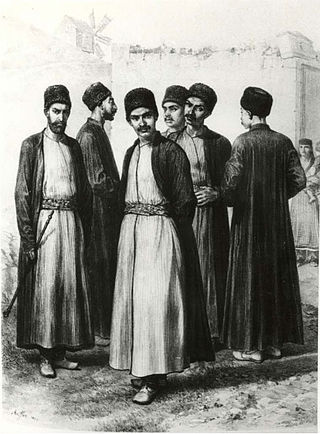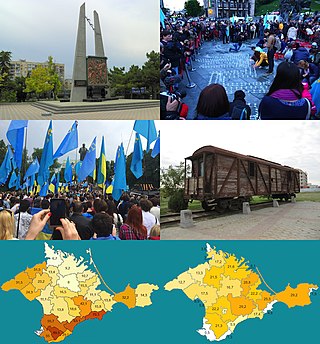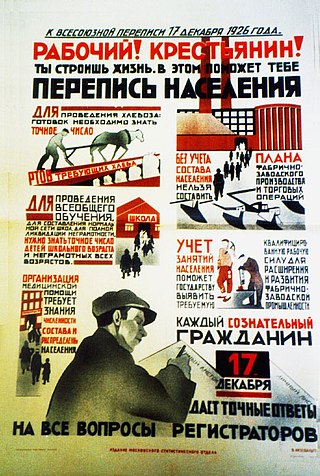This article needs additional citations for verification .(June 2023) |
This is an article about ethnic groups in the city of Kazan, Russia.
This article needs additional citations for verification .(June 2023) |
This is an article about ethnic groups in the city of Kazan, Russia.
The city's population is mainly composed of Tatars (about 48.8 percent) and Russians (about 46.9 percent).

The city's third primary ethnicity is the Chuvash (1.2%), who speak their own language. Chuvash is a Turkic language, which makes it a sister language to Tatar, but it is the most distinct among all the Turkic languages. The Chuvash are Russian Orthodox with some pre-Christian elements in their religion. Other nations native to the Middle Volga are the Maris (0.3%), Udmurts (0.1%), Mordvas (0.2%) and Bashkirs (0.2%). Some of them speak Tatar, some Russian and others their own languages. Bashkirs are normally Muslims. Others, like the Chuvash, are traditionally Orthodox Christian with some pre-Christian elements in their religion.
Some Mari come to Kazan for seasonal work, mostly woodwork and carpentry. They build summer houses and saunas for local people. Chuvash and Mari come to the city every day from their republics and sell potatoes and mushrooms at bazaars.
Ethnic Germans came to Kazan from the 18th century. They served in the Russian Army, or worked in Kazan State University. Some of them are very famous in Kazan, particularly professor Karl Fuchs. During World War II, most of them were repressed and deported/ethnic-cleansed by Joseph Stalin's government.
Today, the remaining Germans of Kazan mostly speak Russian.
A community of Assurs also live in Kazan. By tradition, they work at shoe repairing. Their community lives a closely guarded life, and they do not traditionally mix with other communities.
Since Kazan was not part of the Pale of Settlement, the Jewish community formed relatively late. In 1861, the Jewish population was 184 and mostly consisted of veterans of the Czar's army. By 1897, the population had increased to 1,467 and it continued to grow during World War I as a number of refugees and Jews from Lithuania came to the city. In the 1926, there were 4,156 Jews living in Kazan, making up 2.3% of the population. In the Soviet era, Jewish life was repressed, although the restrictions on Jews and their religious observance were more relaxed in Kazan than other larger cities in the Soviet Union. Jews from Ukraine and other areas in Russia went to Kazan for university because the anti-Jewish quota was more relaxed. In 1970, the Jewish population was 8,000. About 4,000 Jews from Kazan left for the United States and Israel under Gorbachev. After the fall of the Soviet Union, the community reorganized and now has a number communal organizations. Today, Jews number in the tens of thousands. [1]
During World War II a lot of the populations of what would become, after annexation during the war, the Western Soviet Union were deported to Kazan, including schools, educational institutes, and plants. Some of that population did not return to their native lands. They are: Jews, Ukrainians, Belarusians, Poles, and others (nearly 2.5% of population). They speak Russian, sometimes with Ukrainian accent, and many Jews also speak Tatar.
One of the biggest minorities of Kazan is the Azeri community.
Other Caucasians come from Dagestan, Georgia, Armenia and others. They often own cafés or work in construction.
Another big community is the Central Asian community, which includes Uzbeks, Tajiks, Roma (Lyuli branch) and Kyrgyz. Some of the Uzbeks and Tajiks own cafés or fast-food restaurants; they sell dried apricots, popular among Kazan citizens.

Demographic features of the population of Uzbekistan include population growth, population density, ethnicity, education level, health, economic status, religious affiliations, and other aspects of the population. The nationality of a person from Uzbekistan is Uzbekistani, while the ethnic Uzbek majority call themselves Uzbeks. Much of the data is estimated because the last census was carried out in Soviet times in 1989.

Tajiks are a Persian-speaking Iranian ethnic group native to Central Asia, living primarily in Afghanistan, Tajikistan, and Uzbekistan. Tajiks are the largest ethnicity in Tajikistan, and the second-largest in Afghanistan and Uzbekistan. They speak varieties of Persian, a Western Iranian language. In Tajikistan, since the 1939 Soviet census, its small Pamiri and Yaghnobi ethnic groups are included as Tajiks. In China, the term is used to refer to its Pamiri ethnic groups, the Tajiks of Xinjiang, who speak the Eastern Iranian Pamiri languages. In Afghanistan, the Pamiris are counted as a separate ethnic group.

The Tatars, sometimes referred to as Tartars, is an umbrella term for different Turkic ethnic groups bearing the name "Tatar". Initially, the ethnonym Tatar possibly referred to the Tatar confederation. That confederation was eventually incorporated into the Mongol Empire when Genghis Khan unified the various steppe tribes. Historically, the term Tatars was applied to anyone originating from the vast Northern and Central Asian landmass then known as Tartary, a term which was also conflated with the Mongol Empire itself. More recently, however, the term has come to refer more narrowly to related ethnic groups who refer to themselves as Tatars or who speak languages that are commonly referred to as Tatar.

Tatarstan, officially the Republic of Tatarstan, sometimes also called Tataria, is a republic of the Russian Federation, located in Eastern Europe. It is a part of the Volga Federal District; and its capital and largest city is Kazan, an important cultural centre in Russia. The region's main source of wealth is oil with a strong petrochemical industry.

Köräş refers to a number of folk wrestling styles practiced in Central Asia. The English name comes from the term for "wrestling" in some Turkic language.

The Chuvash people, plural: чӑвашсем, çăvaşsem; Russian: чува́ши ) are a Turkic ethnic group, a branch of the Onogurs, native to an area stretching from the Volga-Ural region to Siberia. Most of them live in Chuvashia and the surrounding areas, although Chuvash communities occur throughout the Russian Federation. They speak Chuvash, a unique Turkic language that diverged from other languages in the family more than a millennium ago. Among the Chuvash believers, the majority are Eastern Orthodox Christians.

Russification, or Russianization, is a form of cultural assimilation in which non-Russians, whether involuntarily or voluntarily, give up their culture and language in favor of the Russian culture and the Russian language.

The Khanate of Kazan was a medieval Tatar Turkic state that occupied the territory of former Volga Bulgaria between 1438 and 1552. The khanate covered contemporary Tatarstan, Mari El, Chuvashia, Mordovia, and parts of Udmurtia and Bashkortostan; its capital was the city of Kazan. It was one of the successor states of the Golden Horde, and it came to an end when it was conquered by the Tsardom of Russia.

The Krymchaks are Jewish ethno-religious communities of Crimea derived from Turkic-speaking adherents of Rabbinic Judaism. They have historically lived in close proximity to the Crimean Karaites, who follow Karaite Judaism.
The Mongol invasion of Volga Bulgaria lasted from 1223 to 1236. The Bulgar state, centered in lower Volga and Kama, was the center of the fur trade in Eurasia throughout most of its history. Before the Mongol conquest, Russians of Novgorod and Vladimir repeatedly looted and attacked the area, thereby weakening the Bulgar state's economy and military power. The latter ambushed the Mongols in the later 1223 or in 1224. Several clashes occurred between 1229–1234, and the Mongol Empire conquered the Bulgars in 1236.

The Crimean Karaites or Krymkaraylar, also known as Karaims and Qarays, are an ethnicity of Turkic-speaking adherents of Karaite Judaism in Central and Eastern Europe, especially in the territory of the old Polish-Lithuanian Commonwealth and Crimea. "Karaim" is a Russian, Ukrainian, Belarusian, Polish and Lithuanian name for the community.
Krymchak is a moribund Turkic language spoken in Crimea by the Krymchak people. The Krymchak community was composed of Jewish immigrants who arrived from all over Europe and Asia and who continuously added to the Krymchak population. The Krymchak language, as well as culture and daily life, was similar to Crimean Tatar, the peninsula's majority population, with the addition of a significant Hebrew influence.

The territory of Tatarstan, a republic of the Russian Federation, was inhabited by different groups during the prehistoric period. The state of Volga Bulgaria grew during the Middle Ages and for a time was subject to the Khazars. The Volga Bulgars became Muslim and incorporated various Turkic peoples to form the modern Volga Tatar ethnic group.

The Volga Tatars or simply Tatars are a Turkic ethnic group native to the Volga-Ural region of Russia. They are subdivided into various subgroups. Volga Tatars are the second-largest ethnic group in Russia after ethnic Russians. Most of them live in the republics of Tatarstan and Bashkortostan. Their native language is Tatar, a language of the Kipchak-Bolgar subdivision of the Turkic language family. Majority religion is Sunni Islam.

National delimitation in the Union of Soviet Socialist Republics was the process of specifying well-defined national territorial units from the ethnic diversity of the Union of Soviet Socialist Republics (USSR) and its subregions. The Russian-language term for this Soviet state policy was razmezhevanie, which is variously translated in English-language literature as "national-territorial delimitation" (NTD), "demarcation", or "partition". National delimitation formed part of a broader process of changes in administrative-territorial division, which also changed the boundaries of territorial units, but was not necessarily linked to national or ethnic considerations. National delimitation in the USSR was distinct from nation-building, which typically referred to the policies and actions implemented by the government of a national territorial unit after delimitation. In most cases national delimitation in the USSR was followed by korenizatsiya (indigenization).
Russia, as the largest country in the world, has great ethnic diversity, is a multinational state, and is home to over 190 ethnic groups nationwide. According to the population census at the end of 2021, more than 147.1 million people lived in Russia, which is 4.3 million more than in the 2010 census, or 3.03%. At the same time, only 130.587 million census participants indicated their nationality. The top ten largest nations besides Russians included in descending order: Tatars, Chechens, Bashkirs, Chuvash, Avars, Armenians, Ukrainians, Dargins and Kazakhs. Population censuses in Russia allow citizens to report their nationality according not only to their ancestry, but also to self-identification. The 83 federal subjects which together constitute the Russian Federation include:

The deportation of the Crimean Tatars or the Sürgünlik ('exile') was the ethnic cleansing and cultural genocide of at least 191,044 Crimean Tatars carried out by the Soviet authorities from 18 to 20 May 1944, which was supervised by Lavrentiy Beria, head of Soviet state security and the secret police, and which was ordered by the Soviet leader Joseph Stalin. Within those three days, the NKVD used cattle trains to deport mostly women, children, and the elderly, even Communist Party members and Red Army members, to mostly the Uzbek SSR, several thousand kilometres away. They were one of the several ethnicities who were subjected to Stalin's policy of population transfer in the Soviet Union.

The 1926 Soviet census took place in December 1926. It was the first complete all-Union census in the Soviet Union and was an important tool in the state-building of the USSR, provided the government with important ethnographic information, and helped in the transformation from Imperial Russian society to Soviet society. The decisions made by ethnographers in determining the ethnicity (narodnost) of individuals, whether in the Asiatic or European parts of the former Russian Empire, through the drawing up of the "List of Ethnicities of the USSR", and how borders were drawn in mixed areas had a significant influence on Soviet policies. Ethnographers, statisticians, and linguists were drawing up questionnaires and list of ethnicities for the census. However, they also had the more ambitious goal of deliberately transforming their identities according to the principles of Marxism–Leninism. As Anastas Mikoyan put it, the Soviet Union was "creating and organising new nations".
The history of Chuvashia spans from the region's earliest attested habitation by Finnic peoples to its incorporation into the Russian Empire and its successor states.

The 1959 Soviet census conducted in January 1959 was the first post-World War II census held in the Soviet Union.